
Gays Mills Wisconsin- In the Heart of the Kickapoo Valley
In Remembrance of those now passed and the stories they left behind. May they and
their stories never be forgotten.
Mary L. Coleman Sutherland
HOME PAGE
In Remembrance of those now passed and the stories they left behind. May they and
their stories never be forgotten.
Mary L. Coleman Sutherland
HOME PAGE
| Purchase your e-magazine featuring The Kickapoo Valley at burlingtonnews.net/Legends.html |
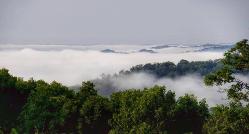
This may look like the Smokey Mountains but Crawford and Richland County has mountains of their own known as the
'Ocooch Mountain Range'. If you have ever been in this area, you will quickly recognize it as 'God's Country'. Courtesy of
Historical and Architectural Tours of Richland Center
'Ocooch Mountain Range'. If you have ever been in this area, you will quickly recognize it as 'God's Country'. Courtesy of
Historical and Architectural Tours of Richland Center
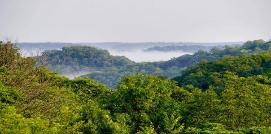
| Brought to you by Legends Magazine - In Search of Legend and Lore . Every Town Has it's own Story Another Sutherland Production Dedicated to James and Dorothy Coleman- Gays Mills Residents burlingtonnews.net/Legends.html |



| Contact Us Legends Magazine 248 Carver Street - Winslow Illinois 61089 bsutherland@wi.rr.com 608 214 6800 or 815 367 1006 HOME PAGE |
Gays Mills Nestled in the Midst of the Ocooch Mountain Range
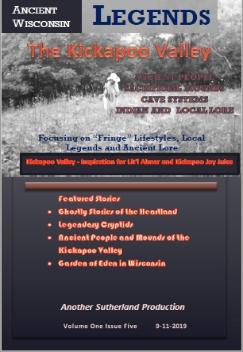
Kickapoo River Valley is one of the oldest river
systems in the world.
At 125 miles, the Kickapoo River is the longest
tributary of the Wisconsin River, meandering from its
source in Wilton to Wauzeka, where it joins the
Wisconsin. The proverbial crow flying between these
two towns would only cover 65 miles. But Kickapoo is
an Algonquin word meaning “one who goes there,
then here,” an accurate description of a river that
manages to flow north, south, east and west for
some portion of its 125 mile length. Because the
glaciers that missed the Driftless Area did not
change its natural course, the Kickapoo River Valley
is one of the oldest river systems in the world.
Rising some 350 feet above the river are the Ocooch
Mountains, named for a small band of Indians called
the Ocoche who once made these hills home. The
“mountains” are really a region of forested hills, lush
valleys and sandstone cliffs
systems in the world.
At 125 miles, the Kickapoo River is the longest
tributary of the Wisconsin River, meandering from its
source in Wilton to Wauzeka, where it joins the
Wisconsin. The proverbial crow flying between these
two towns would only cover 65 miles. But Kickapoo is
an Algonquin word meaning “one who goes there,
then here,” an accurate description of a river that
manages to flow north, south, east and west for
some portion of its 125 mile length. Because the
glaciers that missed the Driftless Area did not
change its natural course, the Kickapoo River Valley
is one of the oldest river systems in the world.
Rising some 350 feet above the river are the Ocooch
Mountains, named for a small band of Indians called
the Ocoche who once made these hills home. The
“mountains” are really a region of forested hills, lush
valleys and sandstone cliffs
Ancient People and Native AmerIndians of the Kickapoo Valley
Sacred Sites and Discovered Artifacts
For more information purchase our Kickapoo Valley Issue
Sacred Sites and Discovered Artifacts
For more information purchase our Kickapoo Valley Issue
The Sacrificial Mounds of Crow Hollow
Near where the Wisconsin River meets the Mississippi runs a serpentine river called the Kickapoo. This river winds up through the Kickapoo Valley into Crawford County…and it
was here, in a small hollow, known as Crow Hollow, ancient tools were discovered, dating back to approximately 3,000 B. C.
Situated on the west highland of the Kickapoo River, about 30 miles northeast of Prairie du Chien, an ancient site was found, where copper tools were found dating to 4,000 B.C.
From the Crawford County dating they were thought to have been made and used approximately 5,000 years ago. These same type of tools were found in Northern Wisconsin as
well.
Crow Hollow site, when discovered and excavated, consisted of a grand or outer circle, enclosing pentagonal or five angled walls, seven truncated mounds of various dimensions
and a small inner circle.
Although most of it has now been defaced by the ravages of time, parts of it may yet be traced. The outer circle was more than twelve hundred feet in circumference; the wall was
from three to five feet in height with a general base diameter of twelve to sixteen feet.
During the 1800's the walls still retained near perfect form ranging from four to six feet in height. The smaller inner circle could be dimly traced, with its greatest elevation noted as
approximately twelve inches. The five small mounds within the pentagon, between it and the small circle, seemed to the observer to have their original form, equal in height to the
wall. The bastion within the entrance of the outer circle was somewhat larger than those found within the pentagon and its form appeared to be yet near perfect.
The central mound was said to have been about thirty-six feet in diameter and still retained a small finish. It was found to be nearly flat on the summit with a slight depression at
the center.
The singular arrangement of the earthwork was built as a sacred national altar where the rituals of human sacrifice were practiced. The summit of the central mound still retained
the traces of fire, containing the remains of burned clay, charcoal and ashes. Remains of the same deposit were found near the surface of five flat mounds adjacent to and south
of the main structure, with the deposits being more abundant in the central mound, than in the other four.
The central mound was held as the most holy sacrificial altar known to tradition; and the peculiar form of the surrounding works show it to have been of the highest order of
sacrificial monuments, dedicated to the offering of human sacrifice only. Recognized as the representative of all five senses, the head was the only thing used for this particular
offering. It was considered the highest and holiest of all offering known to the ancient sacrificial service.
According to their tradition, the human sacrifice was offered at this altar twice a year. One ceremony was given to the sun and the other ceremony given to the moon.
The sun, being the great fountain of light and life through all creation, was supposed to hold the supreme power of the universe, and as supreme ruler, to be worthy of the highest
and holiest adoration.
The moon was adored as the goddess. She was supposed to be assisted in her government by a great serpent, whose form was recognized in the circle that sometimes
surrounds her orb, believed to have special charge of refractory spirits.
The great altar of sacrifice was regarded as the 'holy of holies' or inner sanctuary and no foot save that of a prophet could pass within the sacred walls of the pentagon, after its
completion. Being that the prophets had supreme control of this sanctuary, they resided on the mounds, in the vicinity and immediately adjacent to the work.
The five small mounds within the pentagon were denominated oracular mounds; and one being set apart to each prophet, they frequently retired there to receive oracular
counsels, which, from the summit of the mound at the entrance to the great circle, they subsequently delivered to the people. The five prophets set apart from this service were in
continual attendance…their wants being administered to by the people.
The times of offering sacrifice were in the spring and fall. An offering was made to the sun in the spring, as soon as vegetation began to put forth, with much feasting and great joy.
The second offering took place when the first willow showed its early leaves. The elders of the nation assembled and considering it a privilege, the oldest male would offer his
head in sacrifice. (Also the male might unite with others of his age and cast lots for the privilege.) The human offering was taken to the tent of the senior prophet, who, aided by his
four junior associates, painted the face and adorned his body with a covering of mistletoe, which was the holiest and rarest of evergreens.
They would then conduct him to the oracular mound, located at the entrance of the great circle. The elder prophet and the sacrificial victim would ascend to its summit, and stand
there erect until the people were able to arrange themselves on the summit of the wall. Meanwhile, the younger prophets would walk around the mound and chant songs of
sacrifice.
After the spectators were all arranged in an orderly fashion, the senior prophet would take his sacrifice by the hand and proceed around the circle and the pentagon, with the
younger prophets following behind, walking in pairs and chanting the dirge of sacrifice.
The people on the wall would throw evergreens within the circle at its inner base for the sacrifice to walk on, until the procession had passed five times around the pentagon. Upon
their arrival at the oracular mound, at the termination of the fifth circuit, the younger prophets would arrange themselves around its base.
While the senior prophet and the sacrifice ascended to the summit, both standing erect, the prophet would give a signal for universal silence by drawing forth the knife of sacrifice.
The prophet would then hand the knife to the sacrifice for him to kiss and return. Upon returning the knife to the prophet, the sacrifice would kiss the prophet’s hand. The prophet
would then point the knife to the sun while the sacrifice would lie himself flat down on the summit of the mound with his face positioned upwards, gazing at the ‘Great God of the
Day’. Each of the younger prophets would then seize a hand or foot and hold the sacrifice close to the ground. The circle of spectators, who lined the outer wall, would stand in
perfect silence and wait for the consummation of the sacrifice.
Severing the head from the body, the prophet would then convey the bleeding head to the altar where he would lay it in a position facing the sun. When this was done, the prophet
would descend to the inner circle where he would walk around the altar until the younger prophets had arranged the fuel upon and about the sacrifice. After this was
accomplished, they would then set themselves at the base of the altar. The senior prophet would then ascend to the sacrifice and point his blood stained knife to the sun, awaiting
the return of some of the younger prophets who had gone to his tent to each bring out a band of fire from the ‘holy hearth’. With these, he would kindle the fuel and retire to the
inner circle where he would continue to walk around the altar, while the other prophets fed the flame until the sacrifice was consumed.
As the fire burned, all those in attendance, on the summit of the outer circle, would occasionally point with one hand to the sun and the other to the altar, soliciting their god to
receive the sacrifice and bestow his blessings upon the nation.
The ceremonies would continue until the sun set, then all would retire. Early the next morning, all would resume their position on the circle and about the altar to salute the sun as
it rose. If the sky was clear and the sun rose bright, the fire was again lighted and bountifully fed with fuel for several hours and then suffered to burn without further supply.
When the sun reached the meridian, the prophets, having gathered together the evergreens that were strewed at the base of the circle, would place them on the fire allowing the
smoke to ascend to the sun as the national incense. After these had been consumed, the senior prophet would uncover the body of the victim and place the mistletoe on the
coals, in order for the smoke of this sacrifice to ascend as a sweet savor and disseminate the principles of life that all may inhale and live.
The young prophets would then carry brands of the holy fire to their tents. Each then conveyed a live coal to the tent of the senior prophet, whose hearth alone must supply the fire
used to kindle the sacrificial fire for the holy altar. (The hearth fire is always fed and never extinguished.)
If the sun raised clear, a portion of the sacrificial ashes were delivered, along with the sacrificed body, to the friends or relatives, for monumental commemoration. A part of the
sacrifice is reserved deposit by the prophet in the oracular mounds, to secure intercourse with the dead.
If clouds obscured the rising sun the tribe considered this to be an omen of some national calamity. Indicating disapprobation of the sun, or his refusal to accept the sacrifice, the
body was delivered with wailing and the ashes were retained on the altar in hopes that the sun may look upon them daily and thus are propitiated. If the sun remained obscured
for five successive days, a second sacrifice was offered.
During these ceremonies, an unbroken fast was strictly observed. In the event of a second offering, the nation was required to fast for five days.
In autumn, immediately after the first blighting frost, the same ceremonies were observed. But instead of an elderly male being sacrificed to the sun god, two young virgin maidens
were offered to the moon goddess.
The prophets’ burial mounds were found to be twelve feet long, four feet in depth and six in breadth. They were composed of sand mixed with small bits of mica in the depth of two
feet, covered with white clay to the surface with a thin layer of surface soil.
On the other side of the Hill from Crow Hollow , along the Wisconsin River, near Muscoda is another place of great interest for those treasure and sacred site hunters. The locals
call it Frank's Hill, named from the owner of the land and caretaker Frank.
When Brad and I were investigating this area, the owner of the property told us behind the hill site was reported a cave filled with artifacts and bones of the ancient ones. For years
we have been trying to get more information on this. Tonight I was sent some literature on burial sites of bigfoot. As I was going through it I realized that there was an article in
there confirming that this cave really does exist and it can only be a few miles from Frank's Hill. Now we have a name for the hill site the cave is on...yet apparently the entrance has
been deliberately caved in and knowing that area I am sure it is inhabited by rattle snakes... But here is the story of the cave near Frank's Hill.
Seifert's Cave
The story of Paul Seifert's Cave, in which he claimed to have found remains of extinct animals, large human bones, ancient tools, weapons, and other artifacts in 1891, has been a
topic of local talk around Gotham and Muscoda for over 90 years. But what is not generally known is the discovery of huge human bones in other areas of Wisconsin, which lend
credence to Paul Seifert's claim that he had found a large cavern with the remains of a giant race, which predated the American Indian.
Seifert's cave, which is supposedly in a high bluff on the Wisconsin River between Gotham and Muscoda, first came to public attention as the result of a letter printed in a
Viennese paper by S. Lon Wolfgang. In the letter he described how his friend, Paul Seifert, had sent him relics of great antiquity from the United States. Included among the articles
were spear and arrow points of copper, quartzite, flint, and obsidian, all of giant size, along with numerous ceremonial objects. Seifert offered that if his friend would visit him he
would disclose the secret of where they were found.
The German did so and upon his arrival in Gotham, Wisconsin, was met at the train by Seifert. When the matter of the cave was brought up, Seifert led his friend to it. This was
accomplished by climbing to the top of a hill called Bogus Bluff.
After the climb, the two men proceeded some distance back from the face of the hill and then lowered themselves by rope into a crevice indicated by Seifert. They then found
themselves on a narrow ledge, which led back into a cave, the floor of which was covered with sand and indicated the possibility on an ancient river bed. Numerous passages led
off from the cave and, upon entering one of them, Von Wolfgang was amazed to see a great number of human bones and skulls. Intermingled with them were a large number of
battle axes, spears, and arrow points and pottery fragments, all huge in size. Seifert then indicated that although the cave was known to the local Indians, it was not one of their
burial grounds, and that it had been there as long as they could recall.
Upon his return to Europe, Von Wolfgang printed another letter in the Vienna Courier relating his experiences. He described the cave as being the final resting place of a lost race.
The area in and around Gotham has a multitude of caves, with the area in question being one of the only well-protected ones from both the weather and enemy attack in the
immediate vicinity.
Because he was ridiculed by the local people when he told of his find, Seifert blasted the entrance shut, and all attempts to locate the cave since then have been unsuccessful. If
this cavern does indeed hold the remains of a hitherto-unknown race of people, it could be one of the most important finds of the century and well worth further investigation.
Near where the Wisconsin River meets the Mississippi runs a serpentine river called the Kickapoo. This river winds up through the Kickapoo Valley into Crawford County…and it
was here, in a small hollow, known as Crow Hollow, ancient tools were discovered, dating back to approximately 3,000 B. C.
Situated on the west highland of the Kickapoo River, about 30 miles northeast of Prairie du Chien, an ancient site was found, where copper tools were found dating to 4,000 B.C.
From the Crawford County dating they were thought to have been made and used approximately 5,000 years ago. These same type of tools were found in Northern Wisconsin as
well.
Crow Hollow site, when discovered and excavated, consisted of a grand or outer circle, enclosing pentagonal or five angled walls, seven truncated mounds of various dimensions
and a small inner circle.
Although most of it has now been defaced by the ravages of time, parts of it may yet be traced. The outer circle was more than twelve hundred feet in circumference; the wall was
from three to five feet in height with a general base diameter of twelve to sixteen feet.
During the 1800's the walls still retained near perfect form ranging from four to six feet in height. The smaller inner circle could be dimly traced, with its greatest elevation noted as
approximately twelve inches. The five small mounds within the pentagon, between it and the small circle, seemed to the observer to have their original form, equal in height to the
wall. The bastion within the entrance of the outer circle was somewhat larger than those found within the pentagon and its form appeared to be yet near perfect.
The central mound was said to have been about thirty-six feet in diameter and still retained a small finish. It was found to be nearly flat on the summit with a slight depression at
the center.
The singular arrangement of the earthwork was built as a sacred national altar where the rituals of human sacrifice were practiced. The summit of the central mound still retained
the traces of fire, containing the remains of burned clay, charcoal and ashes. Remains of the same deposit were found near the surface of five flat mounds adjacent to and south
of the main structure, with the deposits being more abundant in the central mound, than in the other four.
The central mound was held as the most holy sacrificial altar known to tradition; and the peculiar form of the surrounding works show it to have been of the highest order of
sacrificial monuments, dedicated to the offering of human sacrifice only. Recognized as the representative of all five senses, the head was the only thing used for this particular
offering. It was considered the highest and holiest of all offering known to the ancient sacrificial service.
According to their tradition, the human sacrifice was offered at this altar twice a year. One ceremony was given to the sun and the other ceremony given to the moon.
The sun, being the great fountain of light and life through all creation, was supposed to hold the supreme power of the universe, and as supreme ruler, to be worthy of the highest
and holiest adoration.
The moon was adored as the goddess. She was supposed to be assisted in her government by a great serpent, whose form was recognized in the circle that sometimes
surrounds her orb, believed to have special charge of refractory spirits.
The great altar of sacrifice was regarded as the 'holy of holies' or inner sanctuary and no foot save that of a prophet could pass within the sacred walls of the pentagon, after its
completion. Being that the prophets had supreme control of this sanctuary, they resided on the mounds, in the vicinity and immediately adjacent to the work.
The five small mounds within the pentagon were denominated oracular mounds; and one being set apart to each prophet, they frequently retired there to receive oracular
counsels, which, from the summit of the mound at the entrance to the great circle, they subsequently delivered to the people. The five prophets set apart from this service were in
continual attendance…their wants being administered to by the people.
The times of offering sacrifice were in the spring and fall. An offering was made to the sun in the spring, as soon as vegetation began to put forth, with much feasting and great joy.
The second offering took place when the first willow showed its early leaves. The elders of the nation assembled and considering it a privilege, the oldest male would offer his
head in sacrifice. (Also the male might unite with others of his age and cast lots for the privilege.) The human offering was taken to the tent of the senior prophet, who, aided by his
four junior associates, painted the face and adorned his body with a covering of mistletoe, which was the holiest and rarest of evergreens.
They would then conduct him to the oracular mound, located at the entrance of the great circle. The elder prophet and the sacrificial victim would ascend to its summit, and stand
there erect until the people were able to arrange themselves on the summit of the wall. Meanwhile, the younger prophets would walk around the mound and chant songs of
sacrifice.
After the spectators were all arranged in an orderly fashion, the senior prophet would take his sacrifice by the hand and proceed around the circle and the pentagon, with the
younger prophets following behind, walking in pairs and chanting the dirge of sacrifice.
The people on the wall would throw evergreens within the circle at its inner base for the sacrifice to walk on, until the procession had passed five times around the pentagon. Upon
their arrival at the oracular mound, at the termination of the fifth circuit, the younger prophets would arrange themselves around its base.
While the senior prophet and the sacrifice ascended to the summit, both standing erect, the prophet would give a signal for universal silence by drawing forth the knife of sacrifice.
The prophet would then hand the knife to the sacrifice for him to kiss and return. Upon returning the knife to the prophet, the sacrifice would kiss the prophet’s hand. The prophet
would then point the knife to the sun while the sacrifice would lie himself flat down on the summit of the mound with his face positioned upwards, gazing at the ‘Great God of the
Day’. Each of the younger prophets would then seize a hand or foot and hold the sacrifice close to the ground. The circle of spectators, who lined the outer wall, would stand in
perfect silence and wait for the consummation of the sacrifice.
Severing the head from the body, the prophet would then convey the bleeding head to the altar where he would lay it in a position facing the sun. When this was done, the prophet
would descend to the inner circle where he would walk around the altar until the younger prophets had arranged the fuel upon and about the sacrifice. After this was
accomplished, they would then set themselves at the base of the altar. The senior prophet would then ascend to the sacrifice and point his blood stained knife to the sun, awaiting
the return of some of the younger prophets who had gone to his tent to each bring out a band of fire from the ‘holy hearth’. With these, he would kindle the fuel and retire to the
inner circle where he would continue to walk around the altar, while the other prophets fed the flame until the sacrifice was consumed.
As the fire burned, all those in attendance, on the summit of the outer circle, would occasionally point with one hand to the sun and the other to the altar, soliciting their god to
receive the sacrifice and bestow his blessings upon the nation.
The ceremonies would continue until the sun set, then all would retire. Early the next morning, all would resume their position on the circle and about the altar to salute the sun as
it rose. If the sky was clear and the sun rose bright, the fire was again lighted and bountifully fed with fuel for several hours and then suffered to burn without further supply.
When the sun reached the meridian, the prophets, having gathered together the evergreens that were strewed at the base of the circle, would place them on the fire allowing the
smoke to ascend to the sun as the national incense. After these had been consumed, the senior prophet would uncover the body of the victim and place the mistletoe on the
coals, in order for the smoke of this sacrifice to ascend as a sweet savor and disseminate the principles of life that all may inhale and live.
The young prophets would then carry brands of the holy fire to their tents. Each then conveyed a live coal to the tent of the senior prophet, whose hearth alone must supply the fire
used to kindle the sacrificial fire for the holy altar. (The hearth fire is always fed and never extinguished.)
If the sun raised clear, a portion of the sacrificial ashes were delivered, along with the sacrificed body, to the friends or relatives, for monumental commemoration. A part of the
sacrifice is reserved deposit by the prophet in the oracular mounds, to secure intercourse with the dead.
If clouds obscured the rising sun the tribe considered this to be an omen of some national calamity. Indicating disapprobation of the sun, or his refusal to accept the sacrifice, the
body was delivered with wailing and the ashes were retained on the altar in hopes that the sun may look upon them daily and thus are propitiated. If the sun remained obscured
for five successive days, a second sacrifice was offered.
During these ceremonies, an unbroken fast was strictly observed. In the event of a second offering, the nation was required to fast for five days.
In autumn, immediately after the first blighting frost, the same ceremonies were observed. But instead of an elderly male being sacrificed to the sun god, two young virgin maidens
were offered to the moon goddess.
The prophets’ burial mounds were found to be twelve feet long, four feet in depth and six in breadth. They were composed of sand mixed with small bits of mica in the depth of two
feet, covered with white clay to the surface with a thin layer of surface soil.
On the other side of the Hill from Crow Hollow , along the Wisconsin River, near Muscoda is another place of great interest for those treasure and sacred site hunters. The locals
call it Frank's Hill, named from the owner of the land and caretaker Frank.
When Brad and I were investigating this area, the owner of the property told us behind the hill site was reported a cave filled with artifacts and bones of the ancient ones. For years
we have been trying to get more information on this. Tonight I was sent some literature on burial sites of bigfoot. As I was going through it I realized that there was an article in
there confirming that this cave really does exist and it can only be a few miles from Frank's Hill. Now we have a name for the hill site the cave is on...yet apparently the entrance has
been deliberately caved in and knowing that area I am sure it is inhabited by rattle snakes... But here is the story of the cave near Frank's Hill.
Seifert's Cave
The story of Paul Seifert's Cave, in which he claimed to have found remains of extinct animals, large human bones, ancient tools, weapons, and other artifacts in 1891, has been a
topic of local talk around Gotham and Muscoda for over 90 years. But what is not generally known is the discovery of huge human bones in other areas of Wisconsin, which lend
credence to Paul Seifert's claim that he had found a large cavern with the remains of a giant race, which predated the American Indian.
Seifert's cave, which is supposedly in a high bluff on the Wisconsin River between Gotham and Muscoda, first came to public attention as the result of a letter printed in a
Viennese paper by S. Lon Wolfgang. In the letter he described how his friend, Paul Seifert, had sent him relics of great antiquity from the United States. Included among the articles
were spear and arrow points of copper, quartzite, flint, and obsidian, all of giant size, along with numerous ceremonial objects. Seifert offered that if his friend would visit him he
would disclose the secret of where they were found.
The German did so and upon his arrival in Gotham, Wisconsin, was met at the train by Seifert. When the matter of the cave was brought up, Seifert led his friend to it. This was
accomplished by climbing to the top of a hill called Bogus Bluff.
After the climb, the two men proceeded some distance back from the face of the hill and then lowered themselves by rope into a crevice indicated by Seifert. They then found
themselves on a narrow ledge, which led back into a cave, the floor of which was covered with sand and indicated the possibility on an ancient river bed. Numerous passages led
off from the cave and, upon entering one of them, Von Wolfgang was amazed to see a great number of human bones and skulls. Intermingled with them were a large number of
battle axes, spears, and arrow points and pottery fragments, all huge in size. Seifert then indicated that although the cave was known to the local Indians, it was not one of their
burial grounds, and that it had been there as long as they could recall.
Upon his return to Europe, Von Wolfgang printed another letter in the Vienna Courier relating his experiences. He described the cave as being the final resting place of a lost race.
The area in and around Gotham has a multitude of caves, with the area in question being one of the only well-protected ones from both the weather and enemy attack in the
immediate vicinity.
Because he was ridiculed by the local people when he told of his find, Seifert blasted the entrance shut, and all attempts to locate the cave since then have been unsuccessful. If
this cavern does indeed hold the remains of a hitherto-unknown race of people, it could be one of the most important finds of the century and well worth further investigation.
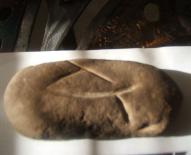
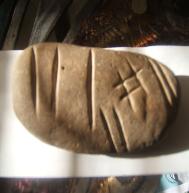
| Ancient artifacts found in a garden area along the river, after a flood , in Gays Mills . Found by Zola According to Tecumseh Brown Eagle, these may be stones of Beltane written in 'Ogham' and called 'Belstones' Frank Joseph also believes they may be prayer stones. The American Ogham inscriptions are the Iberian form of Ogham in which vowels are omitted. These are much older than the Irish Ogham and date from the late Bronze Age and Old Copper Culture, as shown by Punic letters associated with them of dated types. The first side of stone (photo 1) may have been a prayer stone for a safe journey. On the mundane side, the three lines could be the Mississippi, Wisconsin and the Rock which connected to the Crawfish where Aztalan is. The Kickapoo empties into the Wisconsin. the cross-hatch could mean a crossing. On the other side of stone (photo 2) may be a boat? According to Zola (last name withheld) her grandson found these artifacts while digging up the soil in her rose garden. The area is south of Aztalan, not far from the Wisconsin and Kickapoo Rivers. Reader: Zola to Mary Sutherland The Beltane Fire Festival is the present day practice which evolved from the ancient ceremonies of human sacrifice to Bel, represented by the sun and fire. Do you know when the custom at the Crow Hollow mound (Kickapoo Valley – ceased to be practiced? Somehow I know that the bearer of the stone was up there. Why did the powers that be want the stone to be found in my garden at the bottom of a two foot hole dug by my grandson SEAN in order to plant a rose bush? See Mary Sutherland’s book ‘Revelations’ on the Sacrificial Mound of Crow Hollow MS The "Stone", according to the inscription, is from the late Bronze Age (about 800 -1000 B.C.) much older than the Irish Ogham because it omits the vowels. The only source of reference seems to be the one from Vermont in weathered condition. "The inscription reads "Stone of Bel," but when complete it probably read "Stone of Beltane". Since my stone appears to be "complete". I wonder what Ogham mark would have made it read Bel "tane." The deciphering of the Ogham script is fascinating and beyond my scope, but maybe the message has already been delivered. (Bel-tone = ‘Bel’ + ‘ton’ from A-ton which would be more accurate than Bel- “tane” unless of course “tane” is simply an anagram used to represent Aton”. Tane= A-ten , with the vowels e and o being interchangeable MS ) What you wrote about the discovery of a stele in Oklahoma with the inscription in Iberian Punic, the same as on the "Stone of Bel", extracted from the "hymn to the Aton" by Pharaoh Akhenaten. I retrieved a book given to me before I left the Four Corners. It's a Sci-Fi novel written by Daniel Blair Stewart and based on Akhenaten, but titled "AKHUNATON the Extraterrestrial King". This is written on the back of the title page: Genesis, Chapter 6, verse 4: "There were giants in the earth in those days; and also after that, when the sons of God came in unto the daughters of men, and they bare children unto them," |
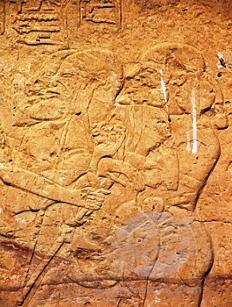
Sugar Grove Tablet
based off Mary Sutherland's research on the Gays Mills and Sugar Grove,a community of Amish.
copyright 2019
My friend JD found this stone carving on land he lives on near Sugar Grove. He said that the land
was once a Paleo Indian settlement which goes back to about 12,000 years ago. He sent it to be
analyzed, but the archeologists said they never saw any thing like it this side of the Mississippi.
However, after several months, he had to ask for it to be returned. It looked Egyptian so I did
some searching and found a similar face on a wall at the Kalabsha Temple.
I sent this photo to Sir Dr. Clifford Alford and this is his thoughts on the Sugar Grove Tablet
Interesting. The picture stone has the best human likenesses I've seen on something north of
Mexico, and the other one is certainly going to give the scientists a run for their money.
From Zola to Mary: Frank Joseph gave me a person to contact at NEARA to analyze the stone.
However, the discovery of identical inscriptions on the one I found in Dr. Barry Fell's book was so
quick to materialize that there was no need to. Interesting to note that on the back of Frank's book,
"The Lost Pyramids of Rock Lake, Frank mentions the book by Barry Fell from which I attained the
picture, "America B.C." He may even have the book. The photo is on page 22.
Interesting at what Clifford said about the Belstone. What does he mean about giving scientists "a
run for their money?" It's most likely the only one of its kind this far West. I dug out my old and
worn book by Lawrence Martin, "The Physical Geography of Wisconsin", published in '65, the
source of material for that course I took back in '80. The end of the last glacial period was about
12,500 years ago. If this was the driftless area, there's a possibility that people lived here. In fact,
the area where JD found the head was a Paleo-Indian (10,000 to 8,000 BC) settlement near Boaz.
FROM: Wikipedia History of Wisconsin
The first known inhabitants of what is now Wisconsin were called Paleo-Indians, who first arrived
in the region in about 10,000 BC. They hunted animals such as mammoths and mastodons. The
Boaz mastodon, and the Clovis artifacts discovered in Boaz, Wisconsin, show that hunting was a
primary occupation for these people. The Plano cultures began to dominate Wisconsin around
7000 BC, as the last glaciers retreated from the state. During the Archaic stage, from 6,000 –
1,000 BC, Wisconsin was inhabited by the Boreal Archaic and the Old Copper Culture Indians.
People during this time lived in small groups or bands, and continued to depend on hunting and
gathering for their existence.
Be careful of referencing culture as Adena - Remember, "Adena" is just an archaeological term;
these people may have been actually known as the Alleg, or Ali, T-Allegwi, Allegwi,or something
like that, although this name too may only have been what their Native American enemies called
them. For Example the AmerIndian term Winnebago literally means 'Cannibal'.
based off Mary Sutherland's research on the Gays Mills and Sugar Grove,a community of Amish.
copyright 2019
My friend JD found this stone carving on land he lives on near Sugar Grove. He said that the land
was once a Paleo Indian settlement which goes back to about 12,000 years ago. He sent it to be
analyzed, but the archeologists said they never saw any thing like it this side of the Mississippi.
However, after several months, he had to ask for it to be returned. It looked Egyptian so I did
some searching and found a similar face on a wall at the Kalabsha Temple.
I sent this photo to Sir Dr. Clifford Alford and this is his thoughts on the Sugar Grove Tablet
Interesting. The picture stone has the best human likenesses I've seen on something north of
Mexico, and the other one is certainly going to give the scientists a run for their money.
From Zola to Mary: Frank Joseph gave me a person to contact at NEARA to analyze the stone.
However, the discovery of identical inscriptions on the one I found in Dr. Barry Fell's book was so
quick to materialize that there was no need to. Interesting to note that on the back of Frank's book,
"The Lost Pyramids of Rock Lake, Frank mentions the book by Barry Fell from which I attained the
picture, "America B.C." He may even have the book. The photo is on page 22.
Interesting at what Clifford said about the Belstone. What does he mean about giving scientists "a
run for their money?" It's most likely the only one of its kind this far West. I dug out my old and
worn book by Lawrence Martin, "The Physical Geography of Wisconsin", published in '65, the
source of material for that course I took back in '80. The end of the last glacial period was about
12,500 years ago. If this was the driftless area, there's a possibility that people lived here. In fact,
the area where JD found the head was a Paleo-Indian (10,000 to 8,000 BC) settlement near Boaz.
FROM: Wikipedia History of Wisconsin
The first known inhabitants of what is now Wisconsin were called Paleo-Indians, who first arrived
in the region in about 10,000 BC. They hunted animals such as mammoths and mastodons. The
Boaz mastodon, and the Clovis artifacts discovered in Boaz, Wisconsin, show that hunting was a
primary occupation for these people. The Plano cultures began to dominate Wisconsin around
7000 BC, as the last glaciers retreated from the state. During the Archaic stage, from 6,000 –
1,000 BC, Wisconsin was inhabited by the Boreal Archaic and the Old Copper Culture Indians.
People during this time lived in small groups or bands, and continued to depend on hunting and
gathering for their existence.
Be careful of referencing culture as Adena - Remember, "Adena" is just an archaeological term;
these people may have been actually known as the Alleg, or Ali, T-Allegwi, Allegwi,or something
like that, although this name too may only have been what their Native American enemies called
them. For Example the AmerIndian term Winnebago literally means 'Cannibal'.
With the discovery of a cave found in Viola,we do know that ancient travelers used the Kickapoo River
as a means of transportation and discovery. This is a photo of what was found there .
as a means of transportation and discovery. This is a photo of what was found there .
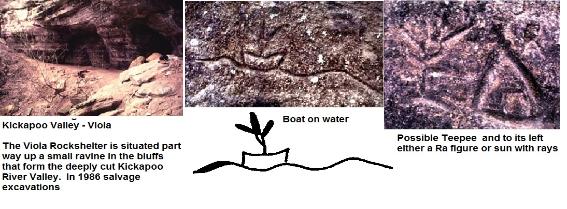
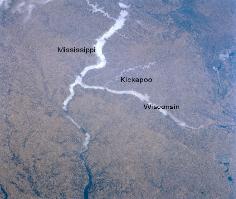
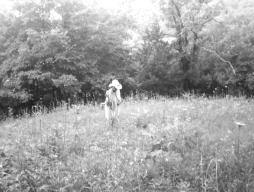
| Mary Sutherland investigating an old cemetery built on an earthen mound located in Crow Hollow , approximately 10 miles from Gays Mills. It has recently come in that this cemetery has burials of civil war soldiers. I suspect that this is one of the mounds mentioned in the article below. Up over this hill ,between the Kickapoo and Wisconsin, near Muscoda is Frank;s Hill, which connects to the story of the ancient people of the Kickapoo Valley. Photo by Brad Sutherland |
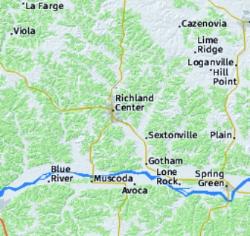
The American monuments stand alone in that they are different from those of any other known.
They are of an older order, entirely and absolutely anomalous. The more we study them, the more we find it necessary to believe that the civilization they represent originated in North
America.
Their early structures included rock and earthen mounds that provided elevated bases for residences of rulers and pedestals for temples and other sacred architecture. Unfortunately
the houses or temples, built of wood and often covered with thatched roofs have disappeared. Many of the mounded earth and rock constructions have also been destroyed through
time, but fortunately for all of us a few still remain intact and stand ready to tell their story.
Pyramids and stepped ziggurats of the ancient world represent the sacred or world mountain such as Mount Meru or Mount Olympus, the home of the gods. They usually contained a
sacred fire which burned perpetually at the temple’s peak. In fact, the word “pyra-mid” itself means “fire in the middle.”
Often they would have a secret system of tunnels built underneath them. , like what you would find under the Giza pyramids, or under the temple of Machu Pichu. They often consisted of
seven steps - seven being the number of godly perfection - and sometimes each step was painted with one of the seven colors of the rainbow, forming a “rainbow bridge” to Heaven.
The Pyramids and stepped ziggurats are representative of Paradise, where the gods live in immortality. And they live not just on the mountain, but in its caverns, which are said to reach
down into the very depths of Hell.
According to the stories, the mountain is often volcanic and is usually surrounded by a body of water, sometimes with four sacred rivers issuing from its peak. This makes the whole
scene a perfect union of the four elements: water (the sea and rivers), fire (the volcanic material within), earth (the mountain itself), and air (the lofty summit of the peak, reaching into
the heavens). This mountain is universally remembered as having been a refuge for both gods and men during the Deluge.
The earthen mounds hold great historical significance. They were built and stand today not only as testament of the antediluvian age of man but to provide us with the first records of
man during and after the great cataclysms.
“In the days of Adam, sacrifice was offered unto the lord. Later it was written, “As soon as the waters of the flood receded, Noah built an altar, upon which to offer sacrifice unto the
Lord.’ This being the first work of Noah, in his advent from the Ark, it would date the custom of the construction of altars to ‘antediluvian origin’, a time ‘before’ the flood.
It is biblically recorded that in the migrations of Lot and Abraham, by divine authority, an ‘altar of earth’ was to be built at each place of sojourning and where ever any circumstance of
importance occurred:
“An altar of earth shalt thou make unto me; and shall sacrifice thereon thy burnt-offering, and thy peace- offering, thy sheep and thine oxen. In all places where I record my name, I will
come unto thee, and I will bless thee.” (Exodus 24-26).
The megaliths served a variety of functions, being used for geodetic markers, recorders of mathematical measurements, observatories and in some cases as military strongholds.
Everything about them is simultaneously simple…yet complex. Their graphics communicate on at least three levels at the same time, being pictorial, mathematical and verbal.
Wisconsin is well known for their mysterious effigy mounds. While archeologists claim the mysterious mound builders left little or no written records as to who they were, we know that
in that time they used the earth as their canvas. So to know the history of these people, it is to understand the symbology of the mounds.
In the first half of the nineteenth century, as the Euro-American explorers traveled westward along Wisconsin’s rivers and trails, they encountered areas where the earth was sculpted
into birds, animals and even people. Amazed, but unsure what to make of their discovery, they drew maps and wrote reports for newspapers, scientific journals and even Congress.
Soon the Wisconsin Territory had become famous for its mysterious effigies.
It was through the diligent work of William Pidgeon and his friend De-Coo-Dah that we owe much in the recovery of the history of our ancient ancestors.
Pidgeon was not only an historian…but also the first ley hunter in the United States.
In 1853, De-Coo-dah, the last medicine man of the Elk Nation, guided Pidgeon through the valleys of the Ohio and Mississippi River. The old chief showed Pidgeon a variety of
earthworks including geometrical constructions and animal or human shapes which today we call ‘effigy mounds’.
Believing these earthworks were built by an ancient vanished race, Pidgeon focused his attention on locating, mapping and documenting as many earthworks as he could. Following
are patterns he observed in their design:
“…This conclusion is further established by the extensive ranges of mounds, extending sometimes in direct and continuous lines for several hundred miles, consisting of truncated
mounds, occasionally varied by effigies, or works of singular form and arrangement. There is little doubt that these ranges were constructed as division lines, or landmarks between
adjacent territories, kingdoms, or tribes. This is evident, not only from the vast extent of territory which these lines include, but from the character of the symbols or effigies which are
always found at points where the principle lines intersect each other, or are joined by lines diverging laterally as seen in Iowa, Wisconsin and Circleville, Ohio.
"After having, in company with De-Coo-Dah, traced several extensive lines of mounds through Wisconsin and Iowa, in the fall of 1849, I visited Circleville in Ohio, with the design of
testing the truth of tradition respecting the union of lineal ranges (Pidgeon's term for leys) at that point. At the junction of the Great Miami River having been traditionally named as the
western terminus of one of the diverging ranges, we assumed a geographical line between that point and Circleville, and soon succeeded in discovering a well-defined mound about
two miles north of Paint Creek, in Fayette County. We proceeded west to the headwaters of the east fork of Todd's Fork of the Little Miami, where we discovered the third work of the
range, in a cultivated field about one half of a mile southeast of Wilmington, Clinton County. Thence we proceeded west to the junction of Todd's Fork with the Miami, about one and a
half miles north of which, on the West Side of that river, we found the fourth work. We then, with the assistance of a pocket-compass, retraced the line, and became fully convinced that it
was, in fact, a lineal range."
Each mound was in the form of a lost form of writing, providing information to the passerby. Seeing and understanding the symbology of the mounds, the passerby could relate to the
cult of the individual involved and their tribal guide, as well as know their specific power ally.
The burials would be found at the "vital" points of the effigy, such as the hips, head or heart area of the animal forms they represented. These points were considered sacred because it
was there where energy was collected, transferred or transformed.
Another important discovery he made was that under each of the markers, lay primary water. Sites would often lie on ridges overlooking a valley with a stream flowing through. The
mounds took on about a dozen shapes such as the conical, bi-conical, oval and linear. They also took on the shapes of the panther, bear, bird (thunderbird, eagle, etc.), deer, buffalo,
turtle, lizard, wolf, fox, beaver, etc. These were arranged in clusters or lines with no regularity as to the forms depicted; the linear and conical ones are mixed with the effigies. Pidgeon
didn’t believe that they bore a relationship to guides or spirits, but was designed to allow the earth energy to build or flow in some way, enhancing or guarding the people and were
portals or dimensional doorways for the spirit to flow in and out of.
The Wisconsin effigy mounds bear a connection to the Serpent Mounds in Ohio and the Nazca Line Effigies. These in turn are connected to the Dragon Projects found in the Mayan and
Egyptian Pyramids.
Vortices play an important part in the location of the effigy mounds which links these sacred sites to others around the world.
It has been suggested that the megalith-builders built megalith structures on a global grid and used the massive sized stones as a storage battery, which was filled and powered by
the concentration of traumatic and enhanced human psychic energy. They deliberately sacrificed humans for the purpose of infusing their energies into the grid! The priests were
rewarded for their efforts by being allowed to participate in the feast of blood and body parts from the sacrificial victim.
War of Extermination
Both the Iroquois and Algonquian legends tell of a great war they had against the Mound builders, who they called ‘the Snakes’. It is on record that an elderly Indian informant in the mid-
19th century recalled that the "First Dispersion" of his people began in the eastern United States, near the Alleghany mountains of Pennsylvania ("Oral Literature and Archaeology," by
Robert J. Salzer. The Wisconsin Archaeologist)
According to the “Wallam Olum” or more commonly known as “The Red Record of the Delaware”, during the great migration of the Lenape, they came across a powerful white skinned,
red haired nation of people who lived in many large towns. They called these people the ‘Taligas’ or ‘Alegwa’ and described them as remarkably tall and stout. Living among them
were giants, people of a much larger size than the tallest of the Lenape.
When the migrating Lenni Lenape reached the Mississippi River, they "sent a message to the Taligas, requesting permission to settle in their neighborhood as friends and allies."
According to “The Red Record”:
“The Talega king denied this request, but promised to permit the Lenape to pass through his lands to find homes farther east. Peacefully, the Lenape began to cross the Mississippi.
But when the Talega King saw how numerous the Lenape were, he became frightened, and ordered his warriors to attack. Talega war canoes swept across the river as armored
Talega regiments massacred the Lenape who had already crossed. Enraged by this treachery, the Lenape vowed to "Conquer the Taligas or die in the process.”
“They joined with their Iroquois allies and declared war against the Tallegwi. No quarter was given, so that the Tallegwi at last, finding that their destruction was inevitable if they
persisted in their obstinacy, abandoned the country to the conquerors and fled down the Mississippi River, from whence they never returned.”
For more information on ancient man and his traditions please purchase my books or five book series 'In Search of Ancient Man' through Amazon or
burlingtonnews.net/books.html
GIANTS AND ANCIENT MAN FOUND IN WISCONSIN
Copper tools have been found in Northern Wisconsin dating to 4,000 B.C. Some of these tools have been found in the area of Crow Hollow, located along the Kickapoo River in
Crawford County. From the dating, they were thought to have been made and used approximately 5,000 years ago.
Stephen H. Long prepared a manuscript in 1823, by the order of the Secretary of War, J. C. Calhoun, based off an early expedition of the earthen mounds found in Wisconsin and the
ancient races that built them. Following is an excerpt from this manuscript: “There are at present but few Indians in the immediate vicinity of the fort, and none can give an account of
the works which are so abundantly scattered over the country. They say that the only means by which they can account for them is to suppose that the country was probably inhabited, at
a period anterior to the most remote traditions, by a race of white men, similar to those of European origin, and that they were cut off by their forefathers. This supposition is grounded
upon the circumstance of their having found human bones buried in the earth at a much greater depth than that, at which they are accustomed to inter their dead; and in graves which
differ from theirs, inasmuch as they are unaccompanied by instruments of any kind, whereas they never omit depositing the arms with the corpse of the deceased. It is also said that
tomahawks of brass and other implements differing from those in common use among the present Indians, have likewise been found under the surface of the ground. The
fortifications appear to them likewise to be a proof of the correctness of their opinion, as none of the Indians are in the habit of constructing works of a similar character, and as indeed
they are unacquainted with the utility of them.”
"Mr. Brisbois, who has been for a long time resident of Prairie du Chien, Wisconsin, informed me that he saw the skeletons of eight persons, that were found, in digging a cellar near
his house, lying side by side. They were of a gigantic size, measuring about eight feet from head to foot. He added that he took a leg bone of one of them and placed it by the side of his
own leg, in order to compare the length of the two. The bone of the skeleton extended six inches above his knee. None of these bones could be preserved as they crumbled to dust
soon after they were exposed to the atmosphere."
Wisconsin evidences the giant race in the discovery of a stone ax that measured twenty-eight inches long, fourteen inches wide, eleven inches thick and weighed three hundred
pounds. Wisconsin Native American Indian lore describe the male giants four times the height of a man and their women remarkably beautiful. One of these races was a race of ‘man-
eating giants’ who preferred humans over any other food. On occasions they massacred whole villages in order to eat the inhabitants and other times they would let some people live
just to fatten them up so that they would be all the tastier later. When the giants wanted to ‘eat soup’, they sometimes challenged the humans to games of chance. If the humans won,
they could kill the giants, but if the giants won, they would kill and eat the humans. Being that the giants were so large, the humans seldom won.
The Native Americans claim the ‘man- eaters’ of Wisconsin disappeared entirely around 1840 when the last of them was slain by a good giant who then reduced himself in size to live
among the humans and bless them.
Another Wisconsin story is that of an Ice Giant who attacked a man on the Wisconsin River between Stevens Point and Wisconsin Rapids. It was only because he was carrying a
powerful medicine with him that he was able to fend off his huge opponent until his friends could come to his rescue.
See Page Four - Native American Indians of Gays Mills Area
SEE GIANTS
They are of an older order, entirely and absolutely anomalous. The more we study them, the more we find it necessary to believe that the civilization they represent originated in North
America.
Their early structures included rock and earthen mounds that provided elevated bases for residences of rulers and pedestals for temples and other sacred architecture. Unfortunately
the houses or temples, built of wood and often covered with thatched roofs have disappeared. Many of the mounded earth and rock constructions have also been destroyed through
time, but fortunately for all of us a few still remain intact and stand ready to tell their story.
Pyramids and stepped ziggurats of the ancient world represent the sacred or world mountain such as Mount Meru or Mount Olympus, the home of the gods. They usually contained a
sacred fire which burned perpetually at the temple’s peak. In fact, the word “pyra-mid” itself means “fire in the middle.”
Often they would have a secret system of tunnels built underneath them. , like what you would find under the Giza pyramids, or under the temple of Machu Pichu. They often consisted of
seven steps - seven being the number of godly perfection - and sometimes each step was painted with one of the seven colors of the rainbow, forming a “rainbow bridge” to Heaven.
The Pyramids and stepped ziggurats are representative of Paradise, where the gods live in immortality. And they live not just on the mountain, but in its caverns, which are said to reach
down into the very depths of Hell.
According to the stories, the mountain is often volcanic and is usually surrounded by a body of water, sometimes with four sacred rivers issuing from its peak. This makes the whole
scene a perfect union of the four elements: water (the sea and rivers), fire (the volcanic material within), earth (the mountain itself), and air (the lofty summit of the peak, reaching into
the heavens). This mountain is universally remembered as having been a refuge for both gods and men during the Deluge.
The earthen mounds hold great historical significance. They were built and stand today not only as testament of the antediluvian age of man but to provide us with the first records of
man during and after the great cataclysms.
“In the days of Adam, sacrifice was offered unto the lord. Later it was written, “As soon as the waters of the flood receded, Noah built an altar, upon which to offer sacrifice unto the
Lord.’ This being the first work of Noah, in his advent from the Ark, it would date the custom of the construction of altars to ‘antediluvian origin’, a time ‘before’ the flood.
It is biblically recorded that in the migrations of Lot and Abraham, by divine authority, an ‘altar of earth’ was to be built at each place of sojourning and where ever any circumstance of
importance occurred:
“An altar of earth shalt thou make unto me; and shall sacrifice thereon thy burnt-offering, and thy peace- offering, thy sheep and thine oxen. In all places where I record my name, I will
come unto thee, and I will bless thee.” (Exodus 24-26).
The megaliths served a variety of functions, being used for geodetic markers, recorders of mathematical measurements, observatories and in some cases as military strongholds.
Everything about them is simultaneously simple…yet complex. Their graphics communicate on at least three levels at the same time, being pictorial, mathematical and verbal.
Wisconsin is well known for their mysterious effigy mounds. While archeologists claim the mysterious mound builders left little or no written records as to who they were, we know that
in that time they used the earth as their canvas. So to know the history of these people, it is to understand the symbology of the mounds.
In the first half of the nineteenth century, as the Euro-American explorers traveled westward along Wisconsin’s rivers and trails, they encountered areas where the earth was sculpted
into birds, animals and even people. Amazed, but unsure what to make of their discovery, they drew maps and wrote reports for newspapers, scientific journals and even Congress.
Soon the Wisconsin Territory had become famous for its mysterious effigies.
It was through the diligent work of William Pidgeon and his friend De-Coo-Dah that we owe much in the recovery of the history of our ancient ancestors.
Pidgeon was not only an historian…but also the first ley hunter in the United States.
In 1853, De-Coo-dah, the last medicine man of the Elk Nation, guided Pidgeon through the valleys of the Ohio and Mississippi River. The old chief showed Pidgeon a variety of
earthworks including geometrical constructions and animal or human shapes which today we call ‘effigy mounds’.
Believing these earthworks were built by an ancient vanished race, Pidgeon focused his attention on locating, mapping and documenting as many earthworks as he could. Following
are patterns he observed in their design:
“…This conclusion is further established by the extensive ranges of mounds, extending sometimes in direct and continuous lines for several hundred miles, consisting of truncated
mounds, occasionally varied by effigies, or works of singular form and arrangement. There is little doubt that these ranges were constructed as division lines, or landmarks between
adjacent territories, kingdoms, or tribes. This is evident, not only from the vast extent of territory which these lines include, but from the character of the symbols or effigies which are
always found at points where the principle lines intersect each other, or are joined by lines diverging laterally as seen in Iowa, Wisconsin and Circleville, Ohio.
"After having, in company with De-Coo-Dah, traced several extensive lines of mounds through Wisconsin and Iowa, in the fall of 1849, I visited Circleville in Ohio, with the design of
testing the truth of tradition respecting the union of lineal ranges (Pidgeon's term for leys) at that point. At the junction of the Great Miami River having been traditionally named as the
western terminus of one of the diverging ranges, we assumed a geographical line between that point and Circleville, and soon succeeded in discovering a well-defined mound about
two miles north of Paint Creek, in Fayette County. We proceeded west to the headwaters of the east fork of Todd's Fork of the Little Miami, where we discovered the third work of the
range, in a cultivated field about one half of a mile southeast of Wilmington, Clinton County. Thence we proceeded west to the junction of Todd's Fork with the Miami, about one and a
half miles north of which, on the West Side of that river, we found the fourth work. We then, with the assistance of a pocket-compass, retraced the line, and became fully convinced that it
was, in fact, a lineal range."
Each mound was in the form of a lost form of writing, providing information to the passerby. Seeing and understanding the symbology of the mounds, the passerby could relate to the
cult of the individual involved and their tribal guide, as well as know their specific power ally.
The burials would be found at the "vital" points of the effigy, such as the hips, head or heart area of the animal forms they represented. These points were considered sacred because it
was there where energy was collected, transferred or transformed.
Another important discovery he made was that under each of the markers, lay primary water. Sites would often lie on ridges overlooking a valley with a stream flowing through. The
mounds took on about a dozen shapes such as the conical, bi-conical, oval and linear. They also took on the shapes of the panther, bear, bird (thunderbird, eagle, etc.), deer, buffalo,
turtle, lizard, wolf, fox, beaver, etc. These were arranged in clusters or lines with no regularity as to the forms depicted; the linear and conical ones are mixed with the effigies. Pidgeon
didn’t believe that they bore a relationship to guides or spirits, but was designed to allow the earth energy to build or flow in some way, enhancing or guarding the people and were
portals or dimensional doorways for the spirit to flow in and out of.
The Wisconsin effigy mounds bear a connection to the Serpent Mounds in Ohio and the Nazca Line Effigies. These in turn are connected to the Dragon Projects found in the Mayan and
Egyptian Pyramids.
Vortices play an important part in the location of the effigy mounds which links these sacred sites to others around the world.
It has been suggested that the megalith-builders built megalith structures on a global grid and used the massive sized stones as a storage battery, which was filled and powered by
the concentration of traumatic and enhanced human psychic energy. They deliberately sacrificed humans for the purpose of infusing their energies into the grid! The priests were
rewarded for their efforts by being allowed to participate in the feast of blood and body parts from the sacrificial victim.
War of Extermination
Both the Iroquois and Algonquian legends tell of a great war they had against the Mound builders, who they called ‘the Snakes’. It is on record that an elderly Indian informant in the mid-
19th century recalled that the "First Dispersion" of his people began in the eastern United States, near the Alleghany mountains of Pennsylvania ("Oral Literature and Archaeology," by
Robert J. Salzer. The Wisconsin Archaeologist)
According to the “Wallam Olum” or more commonly known as “The Red Record of the Delaware”, during the great migration of the Lenape, they came across a powerful white skinned,
red haired nation of people who lived in many large towns. They called these people the ‘Taligas’ or ‘Alegwa’ and described them as remarkably tall and stout. Living among them
were giants, people of a much larger size than the tallest of the Lenape.
When the migrating Lenni Lenape reached the Mississippi River, they "sent a message to the Taligas, requesting permission to settle in their neighborhood as friends and allies."
According to “The Red Record”:
“The Talega king denied this request, but promised to permit the Lenape to pass through his lands to find homes farther east. Peacefully, the Lenape began to cross the Mississippi.
But when the Talega King saw how numerous the Lenape were, he became frightened, and ordered his warriors to attack. Talega war canoes swept across the river as armored
Talega regiments massacred the Lenape who had already crossed. Enraged by this treachery, the Lenape vowed to "Conquer the Taligas or die in the process.”
“They joined with their Iroquois allies and declared war against the Tallegwi. No quarter was given, so that the Tallegwi at last, finding that their destruction was inevitable if they
persisted in their obstinacy, abandoned the country to the conquerors and fled down the Mississippi River, from whence they never returned.”
For more information on ancient man and his traditions please purchase my books or five book series 'In Search of Ancient Man' through Amazon or
burlingtonnews.net/books.html
GIANTS AND ANCIENT MAN FOUND IN WISCONSIN
Copper tools have been found in Northern Wisconsin dating to 4,000 B.C. Some of these tools have been found in the area of Crow Hollow, located along the Kickapoo River in
Crawford County. From the dating, they were thought to have been made and used approximately 5,000 years ago.
Stephen H. Long prepared a manuscript in 1823, by the order of the Secretary of War, J. C. Calhoun, based off an early expedition of the earthen mounds found in Wisconsin and the
ancient races that built them. Following is an excerpt from this manuscript: “There are at present but few Indians in the immediate vicinity of the fort, and none can give an account of
the works which are so abundantly scattered over the country. They say that the only means by which they can account for them is to suppose that the country was probably inhabited, at
a period anterior to the most remote traditions, by a race of white men, similar to those of European origin, and that they were cut off by their forefathers. This supposition is grounded
upon the circumstance of their having found human bones buried in the earth at a much greater depth than that, at which they are accustomed to inter their dead; and in graves which
differ from theirs, inasmuch as they are unaccompanied by instruments of any kind, whereas they never omit depositing the arms with the corpse of the deceased. It is also said that
tomahawks of brass and other implements differing from those in common use among the present Indians, have likewise been found under the surface of the ground. The
fortifications appear to them likewise to be a proof of the correctness of their opinion, as none of the Indians are in the habit of constructing works of a similar character, and as indeed
they are unacquainted with the utility of them.”
"Mr. Brisbois, who has been for a long time resident of Prairie du Chien, Wisconsin, informed me that he saw the skeletons of eight persons, that were found, in digging a cellar near
his house, lying side by side. They were of a gigantic size, measuring about eight feet from head to foot. He added that he took a leg bone of one of them and placed it by the side of his
own leg, in order to compare the length of the two. The bone of the skeleton extended six inches above his knee. None of these bones could be preserved as they crumbled to dust
soon after they were exposed to the atmosphere."
Wisconsin evidences the giant race in the discovery of a stone ax that measured twenty-eight inches long, fourteen inches wide, eleven inches thick and weighed three hundred
pounds. Wisconsin Native American Indian lore describe the male giants four times the height of a man and their women remarkably beautiful. One of these races was a race of ‘man-
eating giants’ who preferred humans over any other food. On occasions they massacred whole villages in order to eat the inhabitants and other times they would let some people live
just to fatten them up so that they would be all the tastier later. When the giants wanted to ‘eat soup’, they sometimes challenged the humans to games of chance. If the humans won,
they could kill the giants, but if the giants won, they would kill and eat the humans. Being that the giants were so large, the humans seldom won.
The Native Americans claim the ‘man- eaters’ of Wisconsin disappeared entirely around 1840 when the last of them was slain by a good giant who then reduced himself in size to live
among the humans and bless them.
Another Wisconsin story is that of an Ice Giant who attacked a man on the Wisconsin River between Stevens Point and Wisconsin Rapids. It was only because he was carrying a
powerful medicine with him that he was able to fend off his huge opponent until his friends could come to his rescue.
See Page Four - Native American Indians of Gays Mills Area
SEE GIANTS



